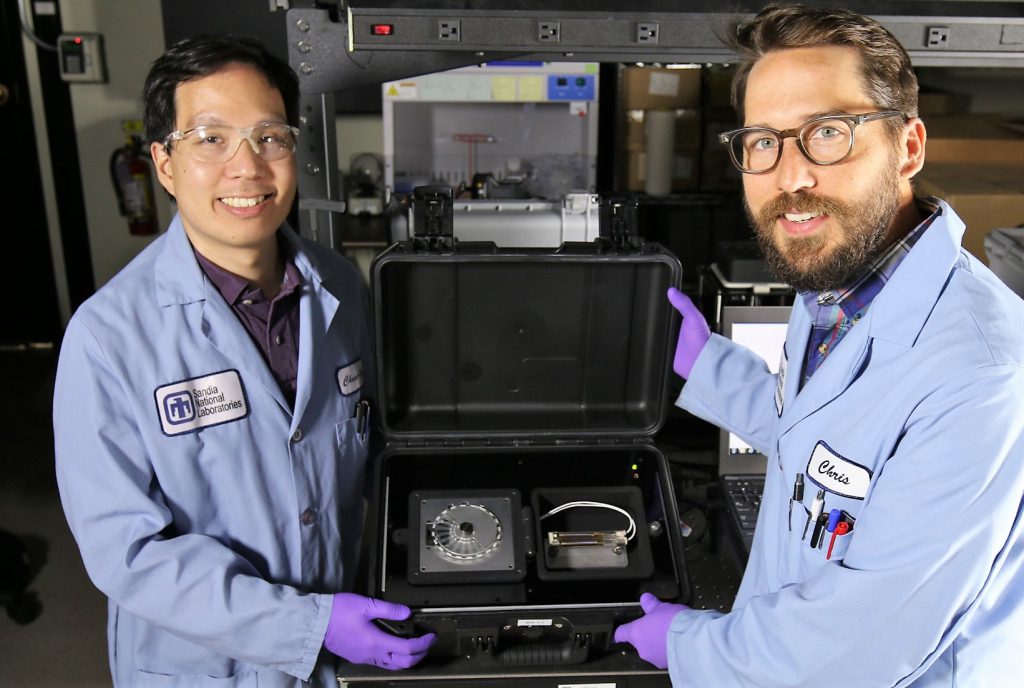SpinDx™: Point-of-Care Diagnostics Using Centrifugal Microfluidics
Researchers at Sandia National Laboratories have developed an innovative technique for conducting simultaneous multiplexed immunoassays and white blood cell counts from a single finger prick of whole blood with less than 15 minutes total sample-to-answer time. The technique is based on centrifugal microfluidics, or “lab-on-a-disk’ technology, which uses centrifugal forces to manipulate samples and reagents through microfluidic channels implanted on disks that are of the same size as a standard CD or DVD.

Sandia system engineers are developing a fully-integrated, portable SpinDx™ prototype for user-friendly sample in, answer out functionality. The system uses touchscreen control pad for assay operation and result dissemination. Miniaturized fluorescence optics are used for detection. Samples are self-collected and loaded onto the device using standard capillary collection tubes. Optional wireless data transmission can be added for remote and point-of-care testing applications. Detection is achieved with a novel bead sedimentation immunoassay scheme. The sample is mixed on-disk with a detection cocktail consisting of a) capture beads coated with antibodies specific for the target(s) of interest, and b) detection antibodies labeled with a fluorescent tag, which will be bound to the capture bead in the presence of the corresponding antigen. Following incubation, the beads are removed from the sample via sedimentation by washing the beads to remove any interferents as the beads stack at the end of the channel. The fluorescent signal of the resulting bead pellet is used to quantify the analyte present. Single channel multiplexing is achieved using beads of different size/density for individual targets.
To obtain blood cell counts, blood samples are mixed on disk with labeling agents (i.e. DNA dyes) to label the leukocytes prior to the centrifugation. The cells then separate along a pre-loaded density media based on their size and density differences. The integrated fluorescent signal of each cell band is used to quantify individual cell population counts.
- Hematology: Leukocyte counts/differentials combined with proteomic detection
- Multiplexed immunoassays: up to 64 parallel assays from a single sample
- Speed: less than 15 minutes sample-to answer
- Minimally-invasive: less than 20µL whole blood input (finger puncture)
- Disposable: Inexpensive disk fabrication with pre-loaded reagents for off-the-shelf processing
- Simple/robust: Based on well-established principles requiring unsophisticated instrumentation
Sandia researchers are currently pursuing additional assay concepts to broaden the diagnostic reach of the SpinDx™ platform, including genomics, viral diagnostics, and metabolomics. The integrated on-disk sample prep and extensive multiplexing capabilities facilitate versatile, “multi-omic” screening at the point-of-care, in the field, or at a centralized laboratory.

- Sandia seeks commercial partners for revolutionary “SpinDx” medical diagnostic tool
Sandia National Laboratories media release (July 12, 2012)
| Patent Title | Patent Number | Grant Date |
|---|---|---|
| System and method for detecting components of a mixture including tooth elements for alignment | 9,500,579 | 11/22/2016 |
| Devices, systems, and methods for conducting assays with improved sensitivity using sedimentation | 9,304,129 | 04/05/2016 |
| Microfluidic devices, systems, and methods for quantifying particles using centrifugal force | 9,186,668 | 11/17/2015 |
SD#11690
Published1/23/2013
Last Updated1/7/2025